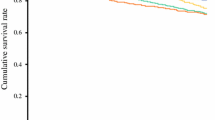Abstract
Purpose
Little is known about the features of gastric cancer located in the lesser and greater curve. This study aims to investigate the clinicopathological features and prognosis of gastric cancer located in the lesser and greater curve.
Patients
From September 2008 to March 2015, 780 gastric cancer patients were enrolled in the present study. The associations between locations and features of patients were analyzed.
Results
There were 571 male (73.2 %) and 209 female (26.8 %) patients. The median age was 56 years (ranged 21–86). There were 684 tumors located in the lesser curve (87.7 %) and 96 located in the greater curve (12.3 %). The incidence of melena was significantly lower in patients with tumors located in the lesser curve than that in the greater curve (8.5 vs 15.6 %, P = 0.024). The median size of tumors in the lesser curve was significantly larger than that in the greater curve (5.0 (0.3–15) vs 4.0 cm (0.5–15), P = 0.001). The remaining clinicopathological features were comparable between the two groups (all P > 0.05). Tumor location was not a risk factor for the prognosis of gastric cancer by univariate and multivariate analysis (both P > 0.05). The postoperative complications (all P > 0.05) and prognoses (P = 0.279) were comparable between tumors located in the lesser and greater curve.
Conclusions
The ratio of gastric cancer located in the lesser to greater curve was 7.1:1. Compared with tumors located in the greater curve, the incidence of melena was significantly lower and the tumor size was significantly larger in tumors located in the lesser curve. The prognoses were comparable between tumors located in the lesser and greater curve.


Similar content being viewed by others
References
Torre LA, Bray F, Siegel RL, Ferlay J, Lortet-Tieulent J, Jemal A. Global cancer statistics, 2012. CA Cancer J Clin. 2015;65(2):87–108.
Chen W, Zheng R, Baade PD, Zhang S, Zeng H, Bray F, et al. Cancer statistics in China, 2015. CA Cancer J Clin. 2016;66(2):115–32.
Marano L, Polom K, Patriti A, Roviello G, Falco G, Stracqualursi A, et al. Surgical management of advanced gastric cancer: an evolving issue. Eur J Surg Oncol. 2016;42(1):18–27.
Liu K, Zhang W, Chen X, Chen X, Yang K, Zhang B, et al. Comparison on clinicopathological features and prognosis between esophagogastric junctional adenocarcinoma (Siewert ii/iii types) and distal gastric adenocarcinoma: retrospective cohort study, a single institution, high volume experience in china. Medicine (Baltimore). 2015;94(34):e1386.
Deng J, Liang H, Zhang R, Sun D, Pan Y, Zhang L, et al. Clinicopathologic characteristics and outcomes of surgery of middle-third gastric cancer. Tumour Biol. 2012;33(6):2091–8.
Cassaro M, Rugge M, Gutierrez O, Leandro G, Graham DY, Genta RM. Topographic patterns of intestinal metaplasia and gastric cancer. Am J Gastroenterol. 2000;95(6):1431–8.
Wang TC, Dangler CA, Chen D, Goldenring JR, Koh T, Raychowdhury R, et al. Synergistic interaction between hypergastrinemia and Helicobacter infection in a mouse model of gastric cancer. Gastroenterology. 2000;118(1):36–47.
Zhao CM, Hayakawa Y, Kodama Y, Muthupalani S, Westphalen CB, Andersen GT, et al. Denervation suppresses gastric tumorigenesis. Sci Transl Med. 2014;6(250):115r–250r.
Colombo F. Gastric ulcer: precancerous lesion. Chir Ital. 1981;33(6):1251–4.
Thomas J, Greig M, McIntosh J, Hunt J, McNeil D, Piper DW. The location of chronic gastric ulcer: a study of the relevance of ulcer size, age, sex, alcohol, analgesic intake and smoking. Digestion. 1980;20(2):79–84.
Brungs D, Aghmesheh M, Vine KL, Becker TM, Carolan MG, Ranson M. Gastric cancer stem cells: evidence, potential markers, and clinical implications. J Gastroenterol. 2016;51(4):313–26.
Yaghoobi M. Bone marrow-derived stem cells in pathogenesis of Helicobacter pylori-associated gastric cancer. Clin Transl Gastroenterol. 2015;6:e110.
Houghton J, Stoicov C, Nomura S, Rogers AB, Carlson J, Li H, et al. Gastric cancer originating from bone marrow-derived cells. Science. 2004;306(5701):1568–71.
Okumura T, Wang SS, Takaishi S, Tu SP, Ng V, Ericksen RE, et al. Identification of a bone marrow-derived mesenchymal progenitor cell subset that can contribute to the gastric epithelium. Lab Invest. 2009;89(12):1410–22.
Genta RM, Hamner HW, Graham DY. Gastric lymphoid follicles in Helicobacter pylori infection: frequency, distribution, and response to triple therapy. Hum Pathol. 1993;24(6):577–83.
Zaitoun AM. The prevalence of lymphoid follicles in Helicobacter pylori associated gastritis in patients with ulcers and non-ulcer dyspepsia. J Clin Pathol. 1995;48(4):325–9.
Jackson RG. Anatomy of the vagus nerves in the region of the lower esophagus and the stomach. Anat Rec. 1949;103(1):1–18.
Acknowledgments
This study was supported in part by grants from the National Natural Scientific Foundation of China [NO. 31100643, 31570907, 81300301, 81572306, 81502403, XJZT12Z03].
Author information
Authors and Affiliations
Corresponding author
Ethics declarations
Conflict of interest
There are no financial or other relations that could lead to a conflict of interest.
Ethical standards
All procedures performed in studies involving human participants were in accordance with the ethical standards of the institutional and/or national research committee and with the 1964 Helsinki Declaration and its later amendments or comparable ethical standards.
Informed consent
Informed consent was obtained from all individual participants included in the study.
Additional information
F. Feng, Y. Tian and M. Guo contributed equally to this work.
Rights and permissions
About this article
Cite this article
Feng, F., Tian, Y., Guo, M. et al. Comparison of clinicopathological features and prognosis of gastric cancer located in the lesser and greater curve. Clin Transl Oncol 19, 457–463 (2017). https://doi.org/10.1007/s12094-016-1549-2
Received:
Accepted:
Published:
Issue Date:
DOI: https://doi.org/10.1007/s12094-016-1549-2




